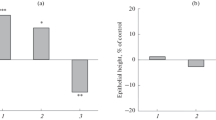Summary
In 1964 a group of 50 persons aged 20–40 years, workers from an environment of carbon monoxide hazards, was examined together with an equally large control group. The values of carbon monoxide in the atmosphere varied, in some cases measuring up to 0.1 volum %, while the level of carboxyhemoglobin in the blood was between 2–26%. The exposure lasted 10,5 years on the average. Internal examination supplemented by blood pressure, EKG, examination of the fundus of the eye and determination of serum lipids did not show any deviations suggesting early development of atherosclerosis in the exposed workers. In 1970 both groups were checked in the same way. During the past six years the degree of exposure had not changed. From the original group of fifty persons 37 workers aged 32–48 years were continuing on to work in this hazardous environment, the exposure lasted 17,5 years on the average, ranging from 11 to 26 years. Even now the clinical condition of the workers from hazardous environments did not show any earlier or more substantial arteriosclerotic changes than the population of similar age span. The average values of serum lipids did not exceed the normal range. We are of the opinion that under the conditions in our places of work the chronic exposure to carbon monoxide does nor represent a primary etiological factor in the development of sclerotic changes of the vessels but that in persons with sclerotic vessels the increase of anoxia associated with at a higher exposure to carbon monoxide might lead to more serious changes of the organs.
Zusammenfassung
Im Jahre 1964 wurde eine Gruppe, die 50 20–40jährige dem CO-Risiko ausgesetzte Arbeiter zählte, sowie eine gleich große Kontrollgruppe untersucht. Die CO-Werte in der Atmosphäre schwanken, bei einigen Messungen erreichen sie bis 0,1 Vol.-%, der Spiegel von Carboxyhämoglobin im Blut bewegte sich zwischen 2–26%. Die Exposition dauerte durchschnittlich 10,5 Jahre. Im internen Befund, der durch Untersuchung des Blutdrucks, Elektrokardiogramm, Augenhintergrund und Bestimmung der Serumlipoide ergänzt wurde, wurden keine Abweichungen gefunden, die auf eine vorzeitige Entwicklung von Atherosklerose bei den exponierten Arbeitern hinweisen würden. Im Jahre 1970 wurde auf dieselbe Weise eine Kontrolle beider Gruppen durchgeführt. Die Höhe der Exposition änderte sich in den letzten 6 Jahren nicht. Von der ursprünglich 50 Personen zählenden Gruppe arbeiteten weiterhin 37 Arbeiter im Alter von 32–48 Jahren auf gefährdeten Arbeitsplätzen; die Dauer der Exposition bewegte sich zwischen 11 und 26 Jahren mit einem Durchschnitt von 17,5 Jahren. Auch jetzt wurden im klinischen Bild der CO-Gefährdeten keine früheren oder ernsteren arteriosklerotischen Veränderungen festgestellt, als sie in der Bevölkerung derselben Altersgrenzen zu finden sind. Die durchschnittlichen Werte der Serumlipoide blieben in den Grenzen der Norm.
Wir sind der Meinung, daß die chronische CO-Exposition, wie sie auf unseren Arbeitsplätzen angeführt wurde, sich nicht als primärer ätiologischer Faktor bei der Entwicklung von sklerotischen Gefäßveränderungen geltend macht, daß jedoch bei Personen mit sklerotischen Gefäßen die Zunahme der Anoxie bei höherer CO-Exposition zu schwereren Organveränderungen führen kann.
Similar content being viewed by others
Literatur
Almgren, S.: 12 Jahre Erfahrungen auf dem Gebiete der chronischen Kohlenoxydvergiftung in Schweden. Arch. Gewerbepath. Gewerbehyg. 13, 1–2, 97–131 (1955).
Astrup, P., Kjeldsen, K., Wanstrup, J.: Enhancing influence of carbon monoxide on the development of atheromatosis in cholesterol-fed rabbits. J. Atheroscler. Res. 7, 343–354 (1967).
Ayers, S. M.: Systemic and myocardial hemodynamic responses to relatively small concentrations of carboxyhemoglobin. Arch. environm. Hlth 18, 699–709 (1969).
Borbély, F.: Kohlenoxyd und Hochdruck. Arch. Gewerbepath. Gewerbehyg. 13, 1–2, 154–165 (1954).
Fiske-Subbarow: The colorimetric determination of phosphorus. J. biol. Chem. 66, 375 (1926).
Forero, A., Donso, J., Chacon, E.: L'électrocardiogramme au cours de l'intoxication oxycarbonée aiguË experimentale. Arch. Mal. prof. 14, 2, 197 (1953).
Goldsmith, J. R.: Carbon monoxide and coronary heart disease. Ann. intern. Med. 71, 199–201 (1969).
Helve, O.: A study of the blood phosphorus and certain lipids in chronic carbon monoxide poisoning. Arch. industr. Hyg. 1, 591 (1950).
Kjeldsen, K.: Influence of prolonged carbon monoxide exposure and altitude hypoxia on serum lipids in man. Scand. J. clin. Lab. Invest. 22, Suppl. 103, 16 (1968).
Kovnackij, M. A.: Klinik der chronischen Kohlenoxydintoxikation [Russ.]. Gig. Tr. prof. Zabol. 10, 25–30 (1961).
Lewey, zit. nach Pfrender, R. E.: Chronic carbon monoxide poisoning. Industr. Med. Surg. 31, 3, 99–103 (1962).
Liebermann-Burchards-Methode: Grundlagen der chemischen Untersuchung in der Medizin [Tschech.]. J. HoŘejší. Stát, zdrav. nakl. Praha, 1958.
Navrátil, M., Weigner, J.: Folgen von akuten Kohlenoxydintoxikationen in der Industrie im internen und neurologischen Bild [Tschech.]. Pracov. Lék. 7, 268 (1955).
Proyard, zitiert nach Petry, H.: Die chronische Kohlenoxydvergiftung. Leipzig: J. A. Barth 1953.
Ripka, O.: Hypertensionskrankheit [Tschech.]. Praha: Stát. zdrav. nakl. 1968.
Schroeder, zit. nach Raymond, V., Vallaud, A.: L'oxyde de carbone et l'oxycarbonisme. Ed. Ins 11/2 (1962).
Sievers, zit. nach Raymond, V., Vallaud, A.: L'oxyde de carbone et l'oxycarbonisme. Ed. Ins 11/2 (1962).
Sumari, P.: After investigations of patients who sufferd from chronic CO poisoning in 1945–1946. Arch. industr. Hlth 12, 554 (1955).
Suzuki, T.: Effects of carbon monoxide inhalation on the fine structure of the rat heart muscle. Tohoku J. exp. Med. 97, 197–211 (1969).
Swahn, B.: Studies on blood lipids. Scand. J. clin. Lab. Invest. 5, Suppl. 9 (1956).
Truhaut, R., Boudène, Cl, Claude, J. R.: Sur quelques reflets humoraux de l'intoxication chronique par l'oxyde de carbon chez le lapin. Ann. Biol. clin. 26, 1249–1260 (1968).
Volfovskaja, R. N., Makulova, I. D.: Zur Frage des Verlaufes der angiodistonischen Zustände mit arterialer Hypertension toxischer ätiologie [Russ.]. Gig. Tr. prof. Zabol. 12, 12–15, 11 (1968).
Wiedermann, D.: Bestimmung von Serumlipoproteinen durch Papierelektrophorese [Tschech.]. VnitŘní Lék. 4, 7 (1958).
Author information
Authors and Affiliations
Rights and permissions
About this article
Cite this article
Přerovská, I., Drdková, S. Der Einfluß der chronischen Einwirkung von Kohlenoxyd auf den klinischen Zustand und biochemische Veränderungen im Serum exponierter Personen in Hinsicht auf die vorzeitige Entwicklung der Atherosklerose. Int. Arch. Arbeitsmed 28, 175–188 (1971). https://doi.org/10.1007/BF00539024
Received:
Issue Date:
DOI: https://doi.org/10.1007/BF00539024



